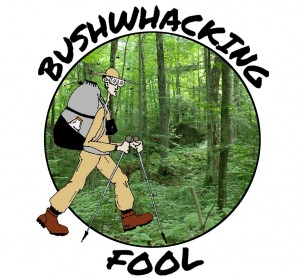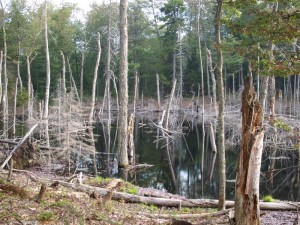
Stygian beaver pond
The following is the first part of a report on the fourth day of a bushwhacking trip through the interior of the southern portion of the Pepperbox Wilderness. The majority of the trip follows along streams and beaver vlys with the exit from the area following a marked herd path from the wild interior of this wilderness area. Highlights along the trip included the Threemile Beaver Meadow, Bear Pond, Moshier Creek and Moshier Reservoir. The first part of the fourth day consisted of passing by some dark and stagnant beaver ponds on the way to Moshier Creek.
Date: September 3, 2010
Length: 0.80 miles (0.80 miles cumulative)
Difficulty: Easy
Just after 5 AM I awoke from a disturbing dream about my run-in with the Brookfield Cult (it was unclear whether the dream took place in Brookfield, NY or not). This cult was located in a sprawling fortress strangely resembling a Wal-mart store. This compound looked like a small city with corporate board rooms, medical facilities, massage parlors (the oddness of the fact that I remember only these three facilities specifically is not lost on me) and just about anything else you could think of all hustling and bustling on a Sunday (obviously not their day of rest).
After taking me into custody (for what I do not recall), they confiscated all my knives (why I was carrying so many remained unclear) and took my car (“It must have been stolen” they claimed). They proceeded to put an ankle bracelet on me, and told me “You don’t know, Jack!” After I escaped their fortress their storm troopers (wayward youths looking for direction in life) pursued me when I was on a backpacking trip.
Damn, I have the weirdest dreams when I am out in the backcountry.
The peculiar dream combined with an urge to relieve myself made it impossible to fall back to sleep so I got up to attend to my garden, so to speak.
While out watering the flowers I noticed a very large (and I mean LARGE) yellow birch with numerous dead limbs towering over my Golite Cave tarp. With the breeze whipping through the canopy all night long and continuing until this morning I considered myself lucky to have made it through the night.
View Day four, part one in a larger map
During breakfast I heard some Canada Geese honking their way through the beaver pond down below my campsite to the west. After the goose ruckus died down I could hear both a swamp sparrow and a common yellowthroat singing down in the direction of the beaver pond too. I especially enjoyed listening to these two species this late in the season given that the breeding period was long over. The ubiquitous red-eyed vireo and the seasonally-challenged spring peepers continued their vocalizations while I ate my breakfast as well.
I noticed a great deal of coral root orchids growing around my campsite. I failed to notice these interesting plants in the dim light during yesterday’s late day arrival. Coral root orchids are peculiar plants that do not depend on photosynthesis for energy but instead rely on symbiotic fungi within their roots for sustenance. These unique plants were plentiful on one of the study plots when I performed avian nest-searching out in Minnesota back in the summer of 1996.
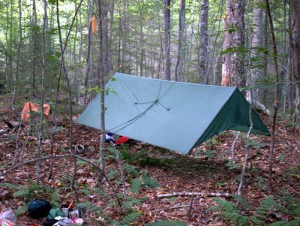
Campsite uphill from beaver pond
Since I had made a conscious choice to get an early start (and the strange Brookfield Cult dream surely helped with this) I was able to eat breakfast and pack-up camp (point #42) and head off toward Moshier Creek by quarter after 7. I may have to get an even earlier start tomorrow morning though, since it would be my last in the backcountry on this trip.
Using my Sliva Ranger compass I took a bearing of 168 degrees toward a wetland located about two-thirds of the way between my present location and a small pond along Moshier Creek. While following this bearing I would stay to the south and west of the small stream, which meandered all the way to the wetland according to my Stillwater 7.5×15 minute quadrangle topographical map.
After climbing uphill through a mature hardwood forest with occasional blow-downs I arrived at a series of beaver ponds (point #43) not located on my map or the aerial photographs I printed online from Bing maps. I assumed they were just additional ponds the beaver made to provide access to the hardwood trees located downstream from the wetland on my map.
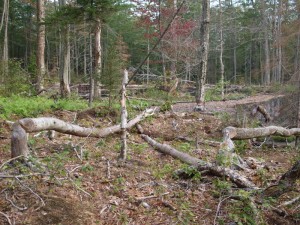
Shoreline of dark beaver ponds
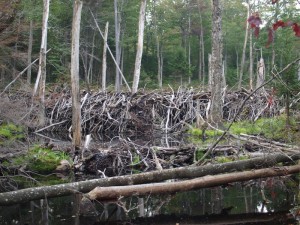
Large beaver dam
While I continued to follow the stream southeast, the beaver ponds got progressively larger. Each was surrounded by many chewed down trees and the areas adjacent to the ponds were open and easy to traverse except for the occasional log. One of the dams was particularly huge and impressive but none of the beaver activity looked very recent and I failed to see any beaver in the area. There were not even any active beavers near the very large lodge located in the pond furthest uphill.
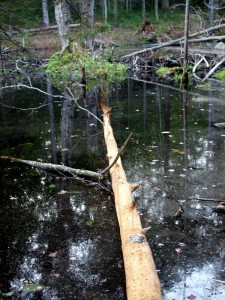
Recent beaver activity
Then it dawned on me that I had not yet seen a beaver on this whole trip or any recent sign of one. This was in stark contrast to my previous trip to this area and my earlier trip this summer through the Five Ponds Wilderness. Has something happened to the beavers of the Pepperbox Wilderness? Some type of disease? Or just a changing landscape providing less ideal beaver habitat? Perhaps a topic for a future blog post.
The water in these ponds was as black as ink. I was happy I had filtered a plentiful supply of water back at my campsite prior to reaching the stygian pools located in this area. I pushed the thoughts that these ponds are the source for the stream near my campsite from my head quickly, preferring to live happily in denial.
The weather continued to be hazy, hot and humid despite the lack of sun due to the fully overcast sky. The breeze from the previous night was still present and thankfully this kept the bug activity subdued. The lack of biting mosquitoes around these dingy ponds was definitely appreciated as I could imagine the stagnant water being an ideal place for a mosquito to raise a family.
Finally I reached the large beaver pond indicated on the map as a wooded wetland (point #44). It was apparent why the map represented the pond as a swamp since the dark water contained numerous snags densely packed together like sardines in a can. The crowded snags gave the pond an eerie air about it.
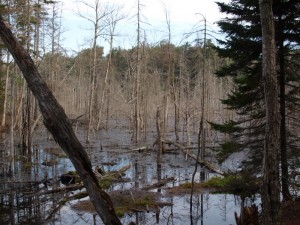
Snag-infested beaver pond
As I moved around the perimeter of the dark, snag-infested pond I stepped over a log chewed down by a beaver a long ago. The end of the log had landed in the water and was cleaned of all bark underneath the murky water. In fact, it looked newly cleaned of its bark. This was the only evidencer of recent beaver activity I noticed while walking around this seemingly-ancient beaver pond.
Once on the opposite side of the pond I stopped, put down my Pinnacle backpack and took a rest on a large downed yellow birch. The log was just the right distance off the ground that my legs dangled down without touching the forest floor. I watched the occasional bird fluttering around the dense snags within the pond and listened to the few birds singing in the area. Along with the persistent red-eyed vireo there were blue jay, hairy woodpecker, pileated woodpecker, black-capped chickadee, and even an eastern phoebe.
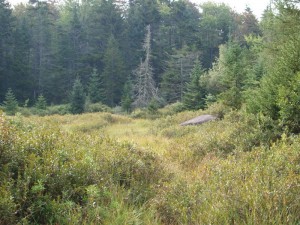
Moshier Creek
While sitting and listening to the few bird songs I heard a splash coming from the direction of the opposite shore of the pond. I quickly got out my Leica 8×20 Ultravid binoculars and started to scan the area. It was incredibly difficult to see anything through the many snags and unfortunately I never detected the cause of the splash before I departed.
Finally I turned my back on the snag-infested, inky beaver pond and headed toward Moshier Creek on a bearing of 115 degrees. The descent began under cover of a mature hardwood forest with a thick American beech understory. The understory slowly transitioned from beech to spruce with the decease in elevation as I approached Moshier Creek. My less-than stealthy approach flushed a ruffed grouse from the ground, startling me for a moment. The forest became exclusively coniferous just before I finally reached the edge of Moshier Creek (point #45); only ten minutes after leaving the snag-filled beaver pond.
